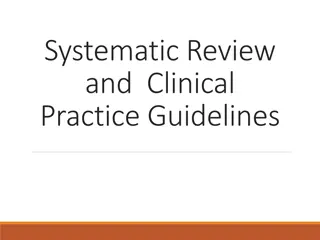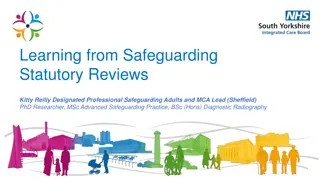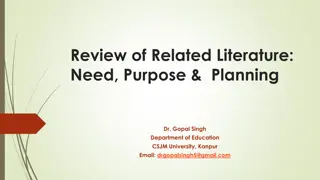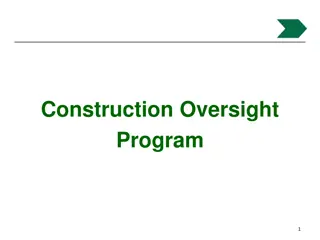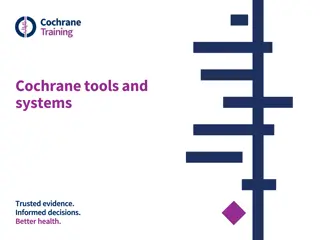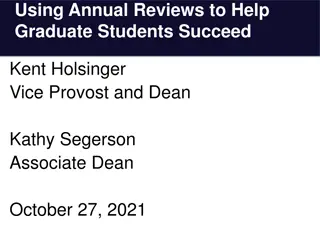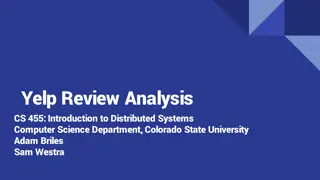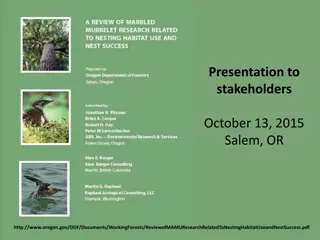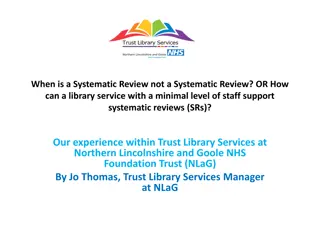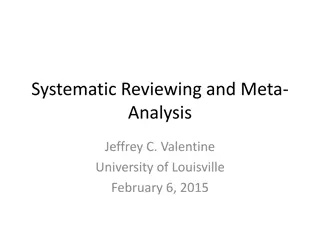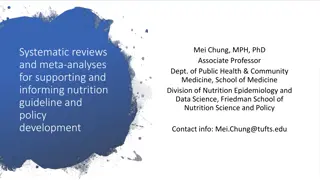Steps for Conducting Systematic Reviews
Systematic reviews are a crucial method for summarizing evidence effectively. This comprehensive guide by Irena Bond provides step-by-step instructions for beginners and junior researchers, including defining a research question, developing inclusion criteria, conducting a search, data extraction, quality assessment, and manuscript writing. The guide also emphasizes the importance of systematic reviews in maintaining up-to-date information in Evidence-Based Medicine.
Download Presentation

Please find below an Image/Link to download the presentation.
The content on the website is provided AS IS for your information and personal use only. It may not be sold, licensed, or shared on other websites without obtaining consent from the author.If you encounter any issues during the download, it is possible that the publisher has removed the file from their server.
You are allowed to download the files provided on this website for personal or commercial use, subject to the condition that they are used lawfully. All files are the property of their respective owners.
The content on the website is provided AS IS for your information and personal use only. It may not be sold, licensed, or shared on other websites without obtaining consent from the author.
E N D
Presentation Transcript
Steps for Conducting Steps for Conducting Systematic Reviews Systematic Reviews Irena Bond, Associate Professor/Library Manager Massachusetts College of Pharmacy and Health Sciences (MCPHS) irena.bond@mcphs.edu June 28, 2023
Goals Goals To provide a step-by-step approach for properly conducting Systematic Reviews (SR) for beginners and junior researchers To provide links to accepted and widely used international templates, checklists, and guidelines used in conducting SR
What is a SR? What is a SR? A systematic review is a review that uses a systematic method to summarize evidence on questions with a detailed and comprehensive plan of study Opposite - Unsystematic narrative review tends to be descriptive, in which the authors select articles based on their point of view which leads to its bias and poorer quality
Why SR? Why SR? Abundance of studies clinical medicine is more complex Studies are often heterogeneous in their design, quality, subjects A well-conducted SR is a feasible solution to keep up-to-date of current Evidence-Based Medicine (EBM) Understanding of SR steps is important for its conduction. It is not easy to be done All steps of SR should be done independently by 2 3 reviewers discussion, to ensure data quality and accuracy
Steps in Conducting SR (1) Steps in Conducting SR (1) 1. 2. 3. 4. 5. 6. 7. 8. 9. 10. Extracting data 11. Quality assessment 12. Data checking 13. Statistical analysis (there are more steps and variety of meta analysis) 14. Double data checking 15. Manuscript writing and submission Development of research question Preliminary research/Forming inclusion/exclusion criteria Search strategy Searching databases Protocol registration Title Abstract Full-text screening Manual searching
Steps for conducting SR Steps for conducting SR Flow chart (1) Flow chart (1) Fig. 1 Detailed flow diagram guideline for systematic review and meta-analysis steps. Note: Star icon refers to 2 3 reviewers screen independently
Research Question Research Question Should be feasible, interesting, novel, ethical, and relevant. It should be clear, logical, and well-defined PICO question framework (usually used for SR of clinical trial study) Patient/Population, Intervention, Comparison, Outcome PICO for an observational study - use without intervention or comparator, in many cases it is usually enough to use P (Patient) and O (outcome) only or PEO-patient, exposure, outcome
Example Example We want to know whether the Ebola vaccine is safe and can induce sufficient immunogenicity to the subjects. Question: How is the safety and immunogenicity of Ebola vaccine in human? P: healthy subjects (human) I: vaccination C: placebo O: safety or adverse effects
Preliminary Research and Idea Validation (1) Preliminary Research and Idea Validation (1) Start by doing a simple search in PubMed or Google Scholar with search terms Ebola AND vaccine Why? to identify relevant articles, ensure the validity of the proposed idea, avoid duplication of previously addressed questions, and assure that we have enough articles for conducting its analysis We find a SR of determinant factors influencing antibody response from vaccination of Ebola vaccine in non-human primate and human, which is a relevant paper to read to get a deeper insight and identify gaps for better formulation of our research question or purpose We can still conduct systematic review and meta-analysis of Ebola vaccine because we evaluate safety as a different outcome and different population (only human)
Inclusion and Exclusion Criteria Inclusion and Exclusion Criteria Eligibility criteria - based on the PICO approach, study design, and date. Exclusion criteria - unrelated, duplicated, unavailable full texts, or abstract-only papers. Exclusions should be stated in advance to refrain the researcher from bias Inclusion criteria - articles with the target patients, investigated interventions, or the comparison between two studied interventions. They contain information answering our research question. Most importantly there should be clear and sufficient information, including positive or negative, to answer the question
Example Example Inclusion & Exclusion Criteria Inclusion & Exclusion Criteria Inclusion Criteria: any clinical trial evaluating the safety of Ebola vaccine no restriction regarding country, patient age, race, gender, publication language, and date Exclusion criteria: study of Ebola vaccine in non-human subjects or in vitro studies Study with data not reliably extracted, duplicate, or overlapping data abstract-only papers as preceding papers, conference, editorial, and author response theses and books articles without available full text available; case reports, case series, and systematic review studies.
Search Strategy Search Strategy A standard search strategy is used in PubMed first Later the PubMed search strategy is modified according to each specific database to get the best relevant results The basic search strategy is built based on the research question formulation (i.e.,PICO). Search strategies are constructed to include free- text terms (e.g., in the title and abstract) and any appropriate subject indexing (e.g., MeSH) expected to retrieve eligible studies, with the help of an expert in the review topic field or an information specialist Outcome terms are usually not searched because outcome is not mentioned obviously in the articles The improvement of the search term is made while doing a trial search and looking for another relevant term within each concept from retrieved papers A detailed search strategy for each database is developed next
Example: Example: The final search strategy for PubMed is as follows: (ebola OR ebola virus OR ebolavirus OR ebola virus disease OR EVD) AND (vaccine OR vaccination OR vaccinated OR immunization) AND ( clinical trial [Publication Type] OR clinical trials as topic [MeSH Terms] OR clinical trial [All Fields]) Because the study for this topic is limited, we do not include outcome term (safety and immunogenicity) in the search term to capture more studies.
PRISMA Flow Diagram PRISMA Flow Diagram Fig. 2 PRISMA flow diagram of studies screening and selection
Search databases, import all results to a Search databases, import all results to a library, and export to an excel sheet library, and export to an excel sheet According to the AMSTAR guidelines, at least two databases have to be searched in the SR, but as you increase the number of searched databases, you get much yield and more accurate and comprehensive results The ordering of the databases depends mostly on the review questions; being in a study of clinical trials, you will rely mostly on Cochrane, mRCTs, or International Clinical Trials Registry Platform (ICTRP) Proposed databases for our topic: PubMed, Scopus, Web of Science, EMBASE, GHL, VHL, Cochrane, Google Scholar, Clinical trials.gov, mRCTs, POPLINE, and SIGLE (grey literature) Finally, all records are collected into one Reference Manager (e.g. Zotero, Mendeley, etc. ) library in order to delete duplicates and then to export records into an excel sheet with essential information for screening
Google Scholar Advanced Search Example Google Scholar Advanced Search Example 1. With all of the words: ebola virus With at least one of the words: vaccine vaccination vaccinated immunization Where my words occur: in the title of the article 2. With all of the words: EVD With at least one of the words: vaccine vaccination vaccinated immunization Where my words occur: in the title of the article
Protocol Writing and Registration Protocol Writing and Registration Protocols describe the rationale, hypothesis, and planned methods of the project before the review has begun and allow readers of completed reviews to identify deviations from planned methods and determine whether the bias impacts the interpretation of review results and conclusions (e.g. criteria you will use to screen literature, how you will search for literature, QA tools you chose etc.) Protocol registration is important at an early stage It guarantees transparency in the research process, feedback from other researchers, and protects from duplication problems It is considered a documented proof of team plan of action, research question, eligibility criteria, intervention/exposure, quality assessment, and pre-analysis plan It is recommended that researchers send it to the principal investigator (PI) to revise it, then upload it to registry sites There are many registry sites available for SR like by Cochrane and Campbell collaborations; PROSPERO is recommended as it is easier. There is a PROSPERO (https://www.crd.york.ac.uk/prospero/) protocol template (1)
Title and Abstract Screening Title and Abstract Screening Decisions to select retrieved articles for further assessment are based on eligibility criteria, to minimize the chance of including non-relevant articles When there is a doubt about an article decision, the team should be inclusive rather than exclusive, until the main leader or PI makes a decision after discussion and consensus All excluded records should be given exclusion reasons
Full text Downloading and Screening Full text Downloading and Screening Reserach4Life Resources Many search engines provide links for free to access full text articles In case not found, we can search in some research websites as Research Gate, which offer an option of direct full-text request from authors. Contact your librarian to explore other options
Manual search Manual search Searching reference lists from included studies/reviews Contacting authors and experts Looking at cited articles in PubMed and Google Scholar (citation tracking- track all the articles that cite each one of the included articles) Looking at relevant (similar) articles All the possible relevant article must undergo further scrutiny against the inclusion criteria, after following the same records yielded from electronic databases, i.e., title/ab abstract and full-text screening Each reviewer has a tag and a distinct method to compile all the results at the end for comparison of differences and discussion and to maximize the retrieval and minimize the bias The number of included articles has to be stated before addition to the overall included records
Data Extraction and Quality Assessment Data Extraction and Quality Assessment Collect data from included full-texts in a structured extraction excel sheet Data presented in graphs is extracted by software tools, e.g. Web plot digitizer (1) The sheet is classified into the study and patient characteristics, outcomes, and quality assessment (QA) In the EBOLA example, extract: name of authors, country of patients, year of publication, study design (case report, cohort study, or clinical trial or RCT), sample size, the infected point of time after EBOLA infection, follow-up interval after vaccination time, efficacy, safety, adverse effects after vaccinations, and QA sheet To evaluate the risk of bias, reviewers should rate each of the 14 items into dichotomous variables: yes, no, or not applicable (NA). An overall score is calculated by adding all the items scores as yes=1, while no and NA = 0. A score will be given for every paper to classify them as poor, fair, or good, where a score from 0 5 was considered poor, 6 9 as fair, and 10 14 as good QA tools (relevance, reliability, validity, applicability) (4). Variety of tools are available for the QA, depending on the design (1)
Data Checking Data Checking Every included article is compared with its counterpart in an extraction sheet, to detect mistakes in data 2 3 independent reviewers should do the data checking ideally not the ones who performed the extraction of those articles. When resources are limited, each reviewer is assigned a different article than the one he extracted in the previous stage
Statistical analysis Statistical analysis Investigators use different methods for combining and summarizing findings of included studies. Before analysis, there is an important step called cleaning of data in the extraction sheet, where the analyst organizes extraction sheet data in a form that can be read by analytical software The analysis consists of 2 types namely qualitative and quantitative analysis. Qualitative analysis mostly describes data in SR studies, while quantitative analysis consists of two main types: MA and network meta-analysis (NMA) (1)
Double Data Checking Double Data Checking For more assurance on the quality of results, the analyzed data should be rechecked from full-text data by evidence photos, to allow an obvious check for the PI of the study.
Manuscript writing, revision, and submission Manuscript writing, revision, and submission to a journal to a journal Writing based on four scientific sections: introduction, methods, results, and discussion, conclusions. Having a characteristic table for study and patient characteristics is a mandatory step (see template in paper) After finishing the manuscript writing, characteristics table, and PRISMA flow diagram, the team should send it to the PI to revise it well and reply to his comments Finally, choose a suitable journal for the manuscript which fits with considerable impact factor and fitting field. Pay attention by reading the author guidelines of journals before submitting the manuscript
References: References: 1. Tawfik, G.M., Dila, K.A.S., Mohamed, M.Y.F. et al. A step by step guide for conducting a systematic review and meta-analysis with simulation data. Trop Med Health 47, 46 (2019). doi.org/10.1186/s41182-0190165-6 2. UNC Libraries. Forming Focused Questions with PICO and other Question Frameworks. Available at: https://guides.lib.unc.edu/pico/about 3. Morgan RL, Whaley P, Thayer KA, Sch nemann HJ. Identifying the PECO: A framework for formulating good questions to explore the association of environmental and other exposures with health outcomes. Environ Int. 2018;121(Pt 1):1027-1031. doi:10.1016/j.envint.2018.07.015 4. UNC Libraries. Systematic Reviews: Step 6: Assess Quality of Included Studies. Available at: https://guides.lib.unc.edu/systematic-reviews/assess-quality 5. Carnegie Melon University. Free Systematic Review and Mata analysis Course. Available at: https://oli.cmu.edu/courses/systematic-reviews-and-meta-analysis-o-f/ 6. Cochrane. Students 4 Best Evidence. Available at: https://s4be.cochrane.org/






